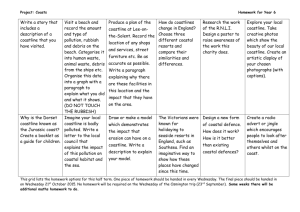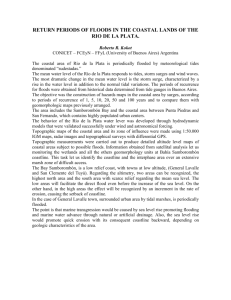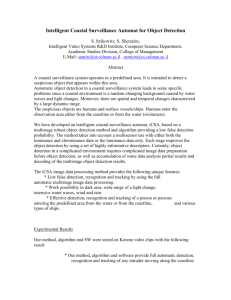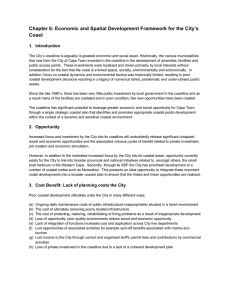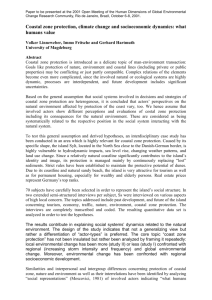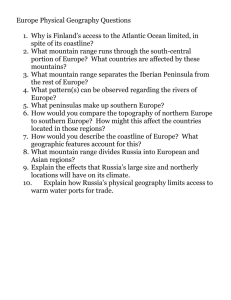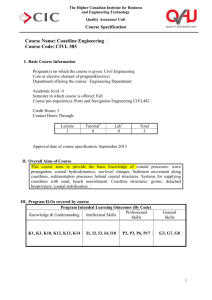COASTLINE EXTRACTION IN VHR IMAGERY USING MATHEMATICAL
advertisement
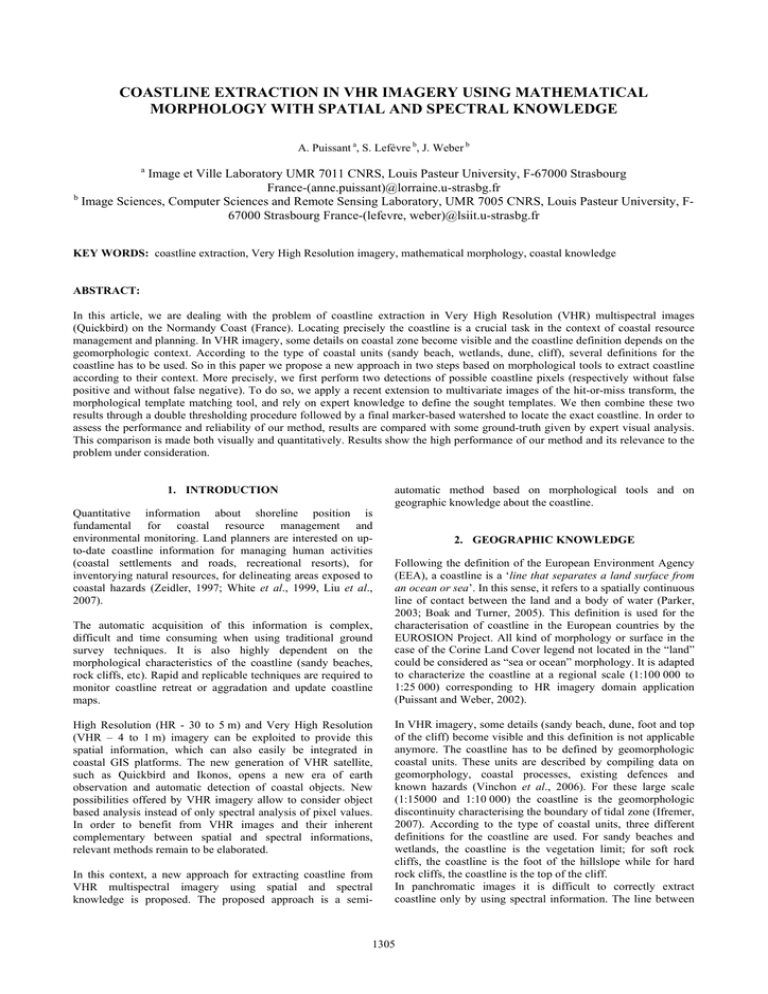
COASTLINE EXTRACTION IN VHR IMAGERY USING MATHEMATICAL MORPHOLOGY WITH SPATIAL AND SPECTRAL KNOWLEDGE A. Puissant a, S. Lefèvre b, J. Weber b a Image et Ville Laboratory UMR 7011 CNRS, Louis Pasteur University, F-67000 Strasbourg France-(anne.puissant)@lorraine.u-strasbg.fr b Image Sciences, Computer Sciences and Remote Sensing Laboratory, UMR 7005 CNRS, Louis Pasteur University, F67000 Strasbourg France-(lefevre, weber)@lsiit.u-strasbg.fr KEY WORDS: coastline extraction, Very High Resolution imagery, mathematical morphology, coastal knowledge ABSTRACT: In this article, we are dealing with the problem of coastline extraction in Very High Resolution (VHR) multispectral images (Quickbird) on the Normandy Coast (France). Locating precisely the coastline is a crucial task in the context of coastal resource management and planning. In VHR imagery, some details on coastal zone become visible and the coastline definition depends on the geomorphologic context. According to the type of coastal units (sandy beach, wetlands, dune, cliff), several definitions for the coastline has to be used. So in this paper we propose a new approach in two steps based on morphological tools to extract coastline according to their context. More precisely, we first perform two detections of possible coastline pixels (respectively without false positive and without false negative). To do so, we apply a recent extension to multivariate images of the hit-or-miss transform, the morphological template matching tool, and rely on expert knowledge to define the sought templates. We then combine these two results through a double thresholding procedure followed by a final marker-based watershed to locate the exact coastline. In order to assess the performance and reliability of our method, results are compared with some ground-truth given by expert visual analysis. This comparison is made both visually and quantitatively. Results show the high performance of our method and its relevance to the problem under consideration. automatic method based on morphological tools and on geographic knowledge about the coastline. 1. INTRODUCTION Quantitative information about shoreline position is fundamental for coastal resource management and environmental monitoring. Land planners are interested on upto-date coastline information for managing human activities (coastal settlements and roads, recreational resorts), for inventorying natural resources, for delineating areas exposed to coastal hazards (Zeidler, 1997; White et al., 1999, Liu et al., 2007). The automatic acquisition of this information is complex, difficult and time consuming when using traditional ground survey techniques. It is also highly dependent on the morphological characteristics of the coastline (sandy beaches, rock cliffs, etc). Rapid and replicable techniques are required to monitor coastline retreat or aggradation and update coastline maps. High Resolution (HR - 30 to 5 m) and Very High Resolution (VHR – 4 to 1 m) imagery can be exploited to provide this spatial information, which can also easily be integrated in coastal GIS platforms. The new generation of VHR satellite, such as Quickbird and Ikonos, opens a new era of earth observation and automatic detection of coastal objects. New possibilities offered by VHR imagery allow to consider object based analysis instead of only spectral analysis of pixel values. In order to benefit from VHR images and their inherent complementary between spatial and spectral informations, relevant methods remain to be elaborated. In this context, a new approach for extracting coastline from VHR multispectral imagery using spatial and spectral knowledge is proposed. The proposed approach is a semi- 2. GEOGRAPHIC KNOWLEDGE Following the definition of the European Environment Agency (EEA), a coastline is a ‘line that separates a land surface from an ocean or sea’. In this sense, it refers to a spatially continuous line of contact between the land and a body of water (Parker, 2003; Boak and Turner, 2005). This definition is used for the characterisation of coastline in the European countries by the EUROSION Project. All kind of morphology or surface in the case of the Corine Land Cover legend not located in the “land” could be considered as “sea or ocean” morphology. It is adapted to characterize the coastline at a regional scale (1:100 000 to 1:25 000) corresponding to HR imagery domain application (Puissant and Weber, 2002). In VHR imagery, some details (sandy beach, dune, foot and top of the cliff) become visible and this definition is not applicable anymore. The coastline has to be defined by geomorphologic coastal units. These units are described by compiling data on geomorphology, coastal processes, existing defences and known hazards (Vinchon et al., 2006). For these large scale (1:15000 and 1:10 000) the coastline is the geomorphologic discontinuity characterising the boundary of tidal zone (Ifremer, 2007). According to the type of coastal units, three different definitions for the coastline are used. For sandy beaches and wetlands, the coastline is the vegetation limit; for soft rock cliffs, the coastline is the foot of the hillslope while for hard rock cliffs, the coastline is the top of the cliff. In panchromatic images it is difficult to correctly extract coastline only by using spectral information. The line between 1305 The International Archives of the Photogrammetry, Remote Sensing and Spatial Information Sciences. Vol. XXXVII. Part B8. Beijing 2008 the black zone (for sea or ocean) and white zone (for land) is not always the boundary of vegetation. Moreover, there are some zones whose spectral features are similar with water body, e.g. lakes or rivers. Then it is necessary to take into account both the multispectral information and the spatial dependence which is based on the neighbouring objects (land and sea) (Zhang et al. 2005). spatial information is of first importance in the problem we are dealing with, our solution relies on the mathematical morphology framework widely used in image processing (Soille, 2003). If the spectral knowledge can be easily identified automatically by samples, the spatial knowledge is difficult to extract automatically. This has to be done by an expert in terms of both geographic objects in the coastal zone (land, sea, and coastal region) and distances between this coastline region and the objects. 3. STUDY SITE AND DATA SOURCE The Normandy Coast (North West France) is an interesting case study to test the proposed approach for extracting coastline features because the three types of coastal units are present and because the coast experiences a high spatial and temporal dynamic caused by natural and anthropic processes: beach erosion and accretion, sediment fluxes caused by dams along the beaches, coastal landslides, cliff retreat (Levoy, 1994, 2000; Costa, 1997, 2000; Maquaire, 1997; Duperret et al., 2002; Costa et Delahaye, 2005) and urbanisation pressure due to the increasing tourism activities and the build-up of recreational resorts. Two areas are especially interesting due to their geomorphologic coastal diversity and dynamics (Figure 1): (1) the coast between Deauville and the Antifer Cape characterized at the same time by wetlands, sandy beaches, soft rock cliffs and hard rock cliffs and (2) the Mont Saint-Michel Bay and especially the 'Dragey' Dune in the North where the dynamics is important due to the high tide coefficients and associated sediment fluxes of the Bay and of the estuaries of the Couesnon, Sée and Sélune rivers. The data used to process the proposed algorithm are two multispectral Quickbird imagery©DigitalGlobe (2002 and 2003) with a 2.4m spatial resolution. These images provide 16-bits multispectral data in the blue (B), green (G), red (R), and nearinfrared (NIR) channels. For each subset, Normalized Difference Vegetation Index (NDVI) and Brightness Index (BI) are calculated in order to complete the spectral knowledge. 4. METHOD Designing an automatic image processing method dedicated to VHR images is a rather complex task. Indeed, these images are characterized by the presence of many irrelevant objects (of no interest for the task under consideration, e.g. coastline extraction in this paper), a higher spectral heterogeneity of the image content, thus making object extraction a very challenging task. Using some geographic knowledge about the objects to be extracted help to solve the problem, but only partially. So we propose here to divide the problem of coastline extraction into two simpler parts which will be solved successively. First we focus on the localization of possible coastline positions, and we identify a set of relevant pixels from the formalized knowledge. Then we involve a second step to build the final result, by generating the spatially continuous line corresponding to the coastline from the set of previously identified pixels. Since the Figure 1. Subset of Quickbird images on four coastal units– (a) wetlands areas, (b) soft rock hillslope, (c) sandy beaches with dunes and (d) hard rock cliff. 4.1 Step 1: Localization of possible coastline positions The process of identifying image pixels or zones corresponding to predefined objects is called template matching. Among the methods which may be involved to solve this problem, mathematical morphology offers the so called hit-or-miss operator which has been proved to be relevant for satellite data analysis (Lefèvre et al., 2007). This operator relies on two predefined templates (called Structuring Elements - SE), one for the sought object or foreground and the other one for its neighbourhood or background. Despite its unique definition for binary images (consisting of the intersection of the foreground erosion by the first structuring element and the background erosion or foreground dilation by the second one), its extension to panchromatic images composed of greyscale-valued pixels led to several definitions, due to the difficulty to define the concepts of foreground and background in non binary images. Nevertheless all the proposed definitions still rely on the erosion and dilation operators. Moving toward the multispectral case is not straightforward, as applying mathematical morphology to multivariate data requires defining vectorial orderings (Aptoula and Lefèvre, 2007). Such a vectorial ordering may not be relevant for all applications, e.g. can we define a way to order spectral bands when dealing with coastline extraction from VHR imagery? So we do not consider the extension of greyscale hit-or-miss to multispectral images using vectorial orderings, but rather use the new multivariate hit-or-miss transform (Weber and Lefèvre, 2008) which first processes each relevant spectral band and then merge the results to ensure spectral correlation. From the knowledge formalization described in the next section, we derive some parameters to be used in the multivariate hit-or- 1306 The International Archives of the Photogrammetry, Remote Sensing and Spatial Information Sciences. Vol. XXXVII. Part B8. Beijing 2008 miss transform. Indeed, each SE is characterized by its shape (a line segment defined by a length and a shift from the origin), its spectral band, its type (i.e. foreground or background) and an intensity profile or more simply a threshold. These elements are given by the expert and correspond to the formalization of his knowledge. Once these parameters have been defined, applying the hit-or-miss transform is done in two steps. First the fitting step consists in identifying all the pixels which fit the template, i.e. whose neighbourhoods correspond to the predefined set of structuring elements. This is done by checking if the local result of the morphological operator (erosion or dilation) is above or below the threshold in the spectral band into consideration. Then all these selected pixels are given a value during the valuation step, the value being proportional to the quality of the fit (a pixel with a value much larger than the threshold is more likely to be relevant). In order the algorithm to be invariant to the coastline orientation, we apply this operator in all possible directions and keep for each pixel the highest response. image B to build the final result with the watershed transform. Figure 2 presents the synopsis of the proposed approach. Apart from the knowledge definition step which is made by the expert, all the subsequent parts of the algorithm are performed in an automatic fashion and do not involve any parameter to be set. Using this template matching operator may lead to incorrect results. Indeed, if the criteria formalized by the expert (neighbourhood size, intensity threshold) are too restrictive, false negative may occur and the result will be incomplete. On the opposite, if the expert gives some criteria which are not enough discriminative, it will result in false positive, i.e. irrelevant pixels will be considered to belong to the coastline. Even a compromise between these two situations will not give a perfect result, and one has to involve more advanced techniques. Figure 2. Flowchart of the two step morphological method. 4.2 Step 2: generate the final connected result Applying the multivariate hit-or-miss transform may either lead to an image with false negative or false positive. Here both results will be used and we consider the expert to give two sets of structuring elements, thus resulting in two different images respectively noted A and B. The first one is too restrictive and leads to false negative (i.e. missed pixels), while the second one is not enough restrictive and leads to false positive (i.e. irrelevant detected pixels). The absence of both false positive in A and false negative in B is ensured with a standard morphological filtering (opening or closing). We make use of these two results through the double thresholding procedure (Soille, 2003), which consists in keeping only the connected components of B which contain at least one pixel of A. In terms of morphological operators, this is achieved by the geodesic reconstruction of the mask B from the marker A, and we use binary images containing all the pixels fitted by the hit-or-miss transform (independently of their valuation). We then obtain an image with does not contain any false negative nor any false positive connected components (not pixels) anymore. However, the coastline contained in this image is rather a wide band, still containing some false positive pixels. Indeed, every pixel of B belonging to an area which contains a pixel in A will be kept, even it is a false positive. So this narrow band is segmented in two parts using the marker-based watershed transform. This morphological segmentation technique requires a topographic surface (here the narrow band, i.e. the grayscale image B without its false positive components) and some markers (here the two areas composed of non fitted pixels on both sides of the narrow band) and return the watershed lines which correspond to the most relevant border between the markers. Thus we use the fitted pixels of A to define the narrow band among the components of B, and we rely on the values given by the hit-or-miss transform in the 5. EXPERIMENTAL RESULTS AND ANALYSIS 5.1 Spectral and spatial coastal knowledge For each image subset (Figure 1), the spectral and spatial coastal knowledge has to be formalized. The formalisation of spatial knowledge consists to define the number of SE characterizing the geographic objects of the coastal zone, their shape (length) and their position (shift). The spectral knowledge formalization concerns the definition of the significant spectral band, the detection threshold and the type of SE (foreground or background). Two SE sets have to be defined, the first is restrictive (for image A) and the second is more wide (for image B). Both are used in step 2 to produce the final result. In general, experts define two or three objects in a coastal zone: (1) land, (2) sea and (3) coastline region. The length parameter is defined according to the size and the homogeneity of the objects. The shift parameter depends on the distance of the object to the coastline. For instance, experts can define a distance in metre for the sea or the sand which are next or far from the coastline. This parameter allows taking into account the tidal zone. It is well-known that the NDVI and PIR bands are interesting to differentiate vegetation (with high values) and sea/ocean (with low values). The threshold can be defined interactively by the expert by a visual analysis of the histogram data according to the image type (date) or automatically by taking examples. For instance, whatever the VHR image and the coastal types, the vegetation gives high values, above 130 150 (for normalized values between 0-255) in the NDVI band while sea has low values in the R and PIR bands. Table 1 summarizes the spatial and spectral knowledge formalization defined for the four coastal units. 1307 The International Archives of the Photogrammetry, Remote Sensing and Spatial Information Sciences. Vol. XXXVII. Part B8. Beijing 2008 SE (a) Wetlands areas (b) Soft rock hillslope (c) Sandy beaches with dunes (d) Hard rock cliff land sand sea sea sea land sea land sea sea land sea Image A (restricted parameters) Spectral band / Length / Shift Threshold [0-255] (m) NDVI > 150 -10 /-5 NDVI > 120 +10/+5 NDVI < 150 +250/+5 PIR < 20 +250/+800 R > 20 +10/+5 NDVI > 130 -5/-5 NDVI < 130 +250/+5 NDVI > 150 -10 /-5 NDVI < 150 +100/+5 PIR < 40 +100/+5 IB > 15 -150/-5 IB < 15 +150/+5 Image B (large parameters) Spectral band / Length / Shift Threshold [0-255] (m) NDVI > 145 -10 /-5 NDVI < 155 +250/+5 NDVI > 125 NDVI < 130 NDVI > 145 NDVI < 150 -5/-5 +100/+5 -10 /-5 +100/+5 IB > 15 IB < 15 -20/-5 +20/+5 Table 1. Formalization of spectral and spatial knowledge parameters for four coastal units For instance, for the wetlands areas (a), in the restricted parameters (for image A), five SE are defined. The first SE allows eliminating land with a NDVI value lower than 150 with a 10 m length. This object is searched in a neighbouring of 5 m. The second SE defines sand next to the coastline (5 m) and with small length (10m). This SE allows identifying sand next to the coastline and then to clean up pond. The following SE allow characterizing the sea near (5m) and far from the coastline (800m) with respectively small (10m) and high length (250m) in R, PIR and NDVI bands. of the coastline and the size of the image. This normalized value can be interpreted as an average location error in each pixel (measured in pixels). An error of 1 means that each detected pixel is (on average) only distant of one pixel from the groundtruth while a value lower than 0.4 ensures a sub-metric precision of the result. 5.2 Results analysis and discussion (a) Wetlands areas (b) Soft rock hillslope (c) Sandy beaches with dunes (d) Hard rock cliff In order to evaluate the proposed method, we have compared the results with some ground-truth consisting in reference coastline given by an expert through visual analysis. Figure 3 compares the reference coastline on Quickbird image (2.4m/spatial resolution) and the coastline feature extracted by our two step morphological method for (a) the wetlands areas and (b) the hard rock cliff. The coastline features extracted on the four coastal units give interesting visual results with only a connected line very close to the ground truth. All false positive are being eliminated. Results are particularly fine when the vegetation limit is used to define the coastline (wetlands, dune). In hard rock cliff (Figure 3b) where the vegetation is present in each part of the coastline but with significant differences in terms of spectral response, the extracted coastline is also well identified. In soft rock hillslope, some differences appear because of the geomorphologic context (heterogeneous) and the presence of shadow due to the image date (November 2002). As far as the quantitative analysis is concerned, we involve two kinds of evaluation measures (Table 2). First we focus on the gap between the two coastline results, and we estimate the area of this gap by counting the pixels located between the two lines. Through the integral operator, we ensure a certain robustness to this criterion. Moreover, we normalize this measure by the size of the reference coastline to get a value invariant to the length Average location error In pixels Normalized 1162 0.45 4835 2.32 2888 1.79 389 0.35 Table 2. Quantitative evaluation measures These quantitative measures confirm the robustness of the method and the visual result. They allow detailing that the coastline is better extracted first on hard rock cliff and wetlands areas with a sub-metric precision (< 0.5). In both other coastal units, the method ensures that each pixel is in average distant from the reference of one or two pixels (2.4 to 5m). Since various objects may lead to false positive (e.g. lakes, rivers, etc), we also evaluate the number of false positive, both in terms of number of pixels and number of objects. The value for the four zones equal to zero for the method proposed. Compared to existing approaches, the proposed method gives particular accurate result for VHR imagery due to simultaneous usage of both spatial and spectral knowledge. For the knowledge specification, several tests have shown at least two SE have to be defined. Indeed, it is essential to formalize the contrast between sea and land. The addition of neighbouring information is also significant when the context contain some objects with the same spectral response (e.g. lake, pond). 1308 The International Archives of the Photogrammetry, Remote Sensing and Spatial Information Sciences. Vol. XXXVII. Part B8. Beijing 2008 Figure 3. Results of the coastline extracted from VHR imagery (Quickbird) by the 2-step morphological method proposed on (a) wetlands areas and (b) hard rock cliff. 6. CONCLUSION AND PERSPECTIVES In this paper we were dealing with the problem of costaline extraction from VHR imagery. This problem is of main importance to help coastal resource management and planning. VHR imagery allows to obtain more precise result than HR imagery, but such images are also more complex to process with automatic methods. We have introduced a new method relying on both spatial and spectral knowledge to be able to deal with various coastal environments. Since the spatial information has to be taken into account in VHR imagery, we rely on mathematical morphology and involve some recent morphological tools dedicated to multivariate (e.g. multispectral) images. In order to ensure a high robustness, the proposed method manages in a first step to extract two results, one without false positive and one without false negative. These results are then merged in a second step by means of a double thresholding procedure followed by a marker-based watershed to produce the final coastline. We have evaluated our approach on various sites of Normandy, France. Using some relevant coastal knowledge, the proposed method is able to accurately extract coastlines in wetland areas, soft rock hillslopes, sandy beaches and dunes, or hard rock cliffs. Moreover, the knowledge formalization task could be performed in a semi- 1309 The International Archives of the Photogrammetry, Remote Sensing and Spatial Information Sciences. Vol. XXXVII. Part B8. Beijing 2008 automatic way by letting the expert to define objects from visual areas on the image and then computing automatically the SE parameters from these areas. Future work will include the use of our method on other kinds of coastal environment, but also on other kinds of geographic objects (not only related to coastal areas). In order to increase the method robustness, we consider to rely on fuzzy hit-or-miss transform. Indeed, this kind of transform has recently shown its interest on grayscale images (Perret et al., 2008) and will need to be extended to multispectral images. accuracy assessment based on Monte Carlo Simulation, Journal of Coastal Research, 23(6), 1359-1369. Parker, B., 2003. The difficulties in measuring a consistently defined shoreline: the problem of vertical referencing. Journal of Coastal Research, 38, 44–56. Perret, B., Lefèvre, S., Collet, C., Vollmer, B., 2008. Astronomical Object Detection with a Robust Hit-or-Miss Transform, EURASIP European, Signal Processing Conference (EUSIPCO), Lausanne, 5 p. Puissant, A., Weber, C., 2002. The utility of very high spatial resolution images to identify urban objects. Geocarto International, 17 (1), 31–41. REFERENCES Aptoula, E., Lefèvre, S., January 2007. A comparative study on multivariate mathematical morphology. Pattern Recognition Vol. 40, No. 11, november 2007, pages 2914-2929. Soille P., 2003. Morphological Image Analysis, SpringerVerlag, 390 p. Baghdadi, N., David, A., Oliveros, C., Gratiot, N., 2004. Apport de l’imagerie pour la cartographie des bancs de vase en guyane française. Revue de la SFPT 175 (3), 27–42. Vinchon C., Balouin Y., Closset L., Garcin M., Idier D., Mallet C., 2006, Evaluation de la réponse géomorphologique du trait de côte au changement climatique, Colloque international 'Interactions nature-Société, analyse et modèles, La Baule, 6 p. Boak, E., Turner, I., 2005. Shoreline definition and detection: a review. Journal of Coastal Research. 21 (4), 688–703. Costa, S., 1997. Dynamique littorale et risques naturels : L’impact des aménagements, des variations du niveau marin et des modifications climatiques entre la baie de seine et la baie de somme (in french). Phd dissertation, Université Paris I. Costa, S., 2000. Réactualisation des connaissances et mise en place d’une methode de suivi de la dynamique du littoral hautnormand et picard (in french). Rapport final. Préfecture de Picardie. Contrat de plan interrégional du bassin de paris (cpibp). Costa, S., Delahaye, D., 2005. Beach erosion of the rives Manche. Pérennité des plages de galets de l’espace rivesmanche-berm; Programme européen de recherche INTERREG II. Rapport final. Diren Haute-Normandie. Ifremer, 2004. Glossaire de l'environnement http://www.ifremer.fr/envlit/glossaire/indexbis.htm Weber, J., Lefèvre, S., 2008. A multivariate Hit-or-Miss transform for conjoint spatial and spectral template matching, IEEE International Conference on Image and Signal Processing, Cherbourg. Springer-Verlag Lecture Notes in Computer Sciences, Volume 5099. 8p. White, K., Asmar, H. E., 1999. Monitoring changing position of coastlines using thematic mapper imagery, an example from the nile delta. Geomorphology 29, 93–105. Zang, Y., Yan, D., Chen F., 2005. A method based on the related information of neighborhood for extracted coastal line, Geoscience and Remote Sensing Symposium, IGARSS’05, Proceedings, pp. 1640-1643. Zeidler, R., 2007. Continental shorelines: climate change and integrated coastal management. Ocean & Coastal Management 37 (1), 41–62. - Lefèvre S., Weber J., Sheeren D., 2007. Automatic building extraction in VHR images using advanced morphological operators, IEEE/ISPRS Joint Workshop on Remote Sensing and Data Fusion over Urban Areas (URBAN), Paris, 4 p. AKNOWLEDGMENT This works was supported by ANR (France) under contract ECOSGIL project ‘Extraction of spatial knowledge for the integrated management of coastal landscape’ (JC05-50539). Liu, H., D. Sherman, and S. Gu, 2007. Automated extraction of tidal datum referenced shoreline from airborne LIDAR data and 1310
